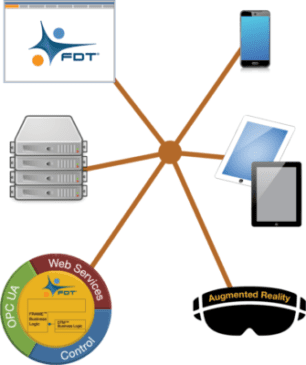
Enhancements include cloud-based enterprise data access, mobility apps, and use of augmented reality to help optimize asset management and preventive maintenance
The FDT Group, an independent, international, not-for-profit industry association supporting FDT® Technology, today announced the latest features of its FDT® Industrial Internet of Things (IIoT) Server (FITS™) solution. Unveiled at HANNOVER MESSE 2017 in Hannover, Germany, the FITS enhancements benefit industrial maintenance departments by enabling cloud-based enterprise data access, mobility apps and the use of augmented reality to view virtual content.
Through FITS, FDT Group is committed to making the IIoT a reality via a broad ecosystem that spans the process, hybrid and factory automation markets, and involves controls and instrumentation suppliers, end users, standards organizations, etc. — all aimed at promoting interoperability, security and mobility through new, adaptive manufacturing assets. This next-generation technology is intended to protect legacy investments in the FDT standard through advanced business logic, well-defined interfaces and common components, while also providing the foundation for a modern, integrated automation architecture.
The FDT architecture is being enhanced to include operating system (OS) agnostic support for standard browsers, and mobility standardization for the development of fit-for-purpose apps to ease maintenance efforts for the new era of automation. Accessible through FITS Web Services, a standardized mobile access approach utilizing browsers, apps, standalone applications or anything else capable of interfacing via web sockets, any mobile device authenticated to access the server will have full access to the topology with tunneling capability to manage assets on any network.
The updated FITS features will spur the development of new apps to optimize asset management, preventive maintenance and other critical functions at modern industrial facilities. They include:
- FITS prototyping with a focus on Web Services and mobile device use cases. This includes Web browser and app-based access to the IIoT server. Whereas FDT maintains its core communication and diagnostic capabilities, it now offers remote access to data through mobile devices and web sockets so that other applications can take part in the seamless exchange of information. FITS opens up the automation architecture to allow for more points of access from a data and user interface perspective.
- Apps employing FITS Web Services to deliver business value to the control industry. Plant personnel are no longer bound to notebook computers, but have the ability to use tablets, smart phones and other mobile devices to carry out their daily activities. For example, field technicians can take pictures or scan bar codes with their smart phones to provide a host of device-specific information. Programmers also have the option to write algorithms to simplify reporting. In addition, it is now easy to write apps communicating with FITS through web sockets. Device vendors and other third parties can deliver apps to support FITS Web Services, focus on specific use cases, or provide helpful tools. Future apps will function similar to a plug-in to an FDT/FRAME™, but will be easier to standardize via a Web application programming interface (API).
- Augmented reality with FITS using a holographic human-machine Interface (HMI) made possible by Microsoft’s HoloLens computing device. Augmented reality is aimed at achieving context-sensitive increases in human perception so as to relocate information transfer, as well as the traditional, screen-based operation of machines, into space itself. With this approach, users can view real-time and analytic data in a hands-free operation. This includes visualizing sensor status, viewing displays of live data and obtaining support for sensor location. They can maintain their normal field of view with transparent data glasses; virtual content is superimposed over real/physical content.
FDT Group Managing Director Glenn Schulz said, “Today, plants and factories utilizing FDT-enabled systems are already benefitting from open access to the Industrial Internet. To advance our support for the IIoT and Industrie 4.0, and to simplify the automation ecosystem exchange, FDT Group has developed a solution known as FITS. It enables mobility, cloud, and fog enterprise applications, as well as sensor-to-cloud and enterprise-wide connectivity employing FRAME™ and DTM™ business logic at the heart of its client-server architecture.”
For automation end users, FITS is delivered as an open, standardized architecture concept, designed to empower the intelligent enterprise and simplify the ecosystem exchange. Users can switch standard protocols for any level of their backbone architecture. It is a versatile approach allowing deployment flexibility. The enhanced architecture is scalable to suit the needs of a single manufacturing facility or an entire industrial enterprise.
FITS is specifically designed to allows sensor, network and topology information to permeate the enterprise, including mobile devices, distributed control systems (DCSs), programmable logic controllers (PLCs), enterprise resource planning (ERP) systems, the IIoT and Industrie 4.0.
FDT Technology currently supports more than 16 automation industry networks, and its open architecture allows users to add networks to meet changing industry demands, including new IIoT/Industrie 4.0 networks such as Message Queuing Telemetry Transport (MQTT). FDT’s ability to seamlessly nest or tunnel through a myriad of networks to transparently communicate with the end device demonstrates its pivotal position in today’s smart, connected enterprise.
About FDT Group AISBL
The FDT Group AISBL is an international non-profit corporation consisting of leading worldwide member companies active in industrial automation and manufacturing. The major purpose of the FDT Group is to provide an open standard for enterprise-wide network and asset integration, innovating the way automation architectures connect and communicate sensor to cloud for the process, hybrid and factory automation markets. FDT Technology benefits both manufacturers and end users, with advancements such as the Industrial Internet of Things (IIoT) and Industrie 4.0 delivered out-of-the-box – enabling modernized asset integration and access to performance data for visualizing crucial operational problems. Around the world, end users, manufacturers, universities, and research organizations are working together to develop the technology; provide development tools, support, and training; coordinate field trials and demonstrations; and enable product interoperability.
FDT® is a registered trademark, and FDT/FRAME™, FDT/DTM™ and FITS™ are trademarks of the FDT Group AISBL.
###